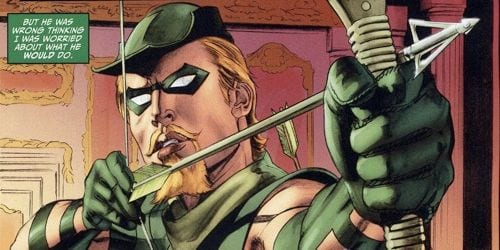
The Empty Threat.
With Justice League: Rise and Fall One-Shot, the special that kick-starts the twin storylines of “Rise of Arsenal” and “Fall of Green Arrow”, there is just the right kind of raw, unrequited emptiness.
In the wake of events chronicled in the closing stages of Cry For Justice, the League must deal with the consequences of an artificially detonated earthquake that blasted Star City. While the threat has passed, danger remains. The supervillains responsible remain at large, but the city itself threatens to splinter into riots, muggings and lootings. Nowhere seems safe, and members of the League interdict in situations on the ground to prevent the loss of life. It is in this nightmarish hell that fleeing villains make one final attack.
“Rise and Fall”, a storyline which has its prologue in both the closing stages of Cry for Justice and Green Arrow #30, commences properly with Justice League: Rise and Fall One-Shot. This book details the single worst tragedy to befall Roy Harper, formerly Arsenal, erstwhile kid sidekick Speedy to Oliver Queen’s Green Arrow, and current Justice Leaguer, Red Arrow. For Roy Harper it is the worst of days, following on from murder of his daughter Lian in the wake of the Star City disaster, villainous mastermind Prometheus breaks into the JLA Watchtower and succeeds in dismembering Roy’s right hand.
Although the one-shot has a strong focus on Green Arrow, his protégé, and the relationships both have built up during their time spent with various incarnations of the League, writer J. T. Krul does manage to craft a fine and resonating story of the Justice League itself.
The conversation between Wally West’s Flash and Rich Grayson’s Batman, formerly Kid Flash and Robin, both (along with Roy Harper) founding members of the Teen Titans, is one of the most haunting in recent comics memory. Not only is there a solidarity with Red Arrow, but also a questioning of their legacies, and their individual choices to adopt the roles, and mantles of their mentors. Krul’s dialogue here can easily be read as a comment on the apparent intergenerational obligation to continue being comics readers.
Three’s Company: Three recently resurrected heroes confront each other in the rubble of Star City
The conversation between the recently resurrected Green Lantern of Hal Jordan and recently resurrected Flash of Barry Allen, equally taps an emotional vein. Beyond the troika of Bruce Wayne’s Batman, Clark Kent’s Superman and Princess Diana’s Wonder Woman, Krul passionately shows how the League has always been about its slightly less mythological characters. Silver Age Flash and Green Lantern are unique and important contributions, not only in terms of their powers, but also their temperament. Barry and Hal’s conversation as they hunt down Prometheus, is doubly telling when contrasted against Wally and Rich’s.
After the one-shot, the “Rise and Fall” storyline splinters into two; “The Fall” continues in the pages of Green Arrow issue #31 onwards, while the “The Rise” continues in the four-parter, The Rise of Arsenal.
To Krul’s credit, the sense of devastation never abates. There is a moral bleakness in telling a tale of superheroes fighting against ordinary people to stem the loss of life, while at the same time needing to stare down tragedies of their own. The anguish of Roy Harper seemingly reliving psychotropic flashbacks from his time addicted to heroin, begins an almost perfect story of an upward swing that will mark his “Rise”. But while Roy Harper is on the cusp of the elevation of his spirit, Oliver Queen’s Green Arrow is getting ready for a fall.
Unable to process what has happened to his protégé, Oliver Queen taps a primal hunter which originally formed the basis for his superhero alter ego. The Green Arrow as the Longbow Hunter. In the opening stages of the Rise and Fall one-shot, he takes it upon himself to murder Prometheus, the mastermind behind the plot to cripple Star City, murder Roy Harper’s daughter Lian, and take the Red Arrow’s arm. While the rest of the League interdicts in Star City and hunts down the escaped villains, Oliver’s intention is to find the Electrocutioner, the trigger-man for the devastation, and murder him as well.
The Rise of Arsenal #1 reads like it should; the continuance of devastation from the city-wide into the personal. Green Arrow #31 however, which kicks off the “Fall of Green Arrow” storyarc, reads surprisingly like police procedural. But that absolute focus, and lack of distraction, that unflinching certitude becomes stark when readers realize that this procedural will not end in capture and justice, but in murder. In one swift blow, J.T. Krul has become the equal of Jim Thompson’s The Killer Inside Me.

![Call for Papers: All Things Reconsidered [MUSIC] May-August 2024](https://www.popmatters.com/wp-content/uploads/2024/04/all-things-reconsidered-call-music-may-2024-720x380.jpg)



